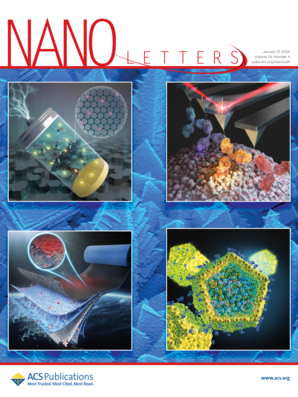Surface-Dominated Quantum-Metric-Induced Nonlinear Transport in the Layered Antiferromagnet CrSBr
IF 9.6
1区 材料科学
Q1 CHEMISTRY, MULTIDISCIPLINARY
引用次数: 0
Abstract
The van der Waals (vdW) antiferromagnet CrSBr has recently garnered significant attention due to its air stability, high magnetic transition temperature, and semiconducting properties. We investigate its nonlinear transport properties and identify a quantum-metric-dipole (QMD)-induced nonlinear anomalous Hall effect and nonlinear longitudinal resistivity, which switch signs upon reversing the Néel vector. The significant QMD originates from Dirac nodal lines near the conduction band edge within the experimentally achievable doping range. Knowing the weak interlayer coupling, it is unexpected that the nonlinear conductivities do not scale with the sample thickness but are dominantly contributed by surface layers. In the electron-doped region, the top layer dominates the response, while the top three layers contribute the most in the hole-doped region. Our results establish topological nodal lines as a guiding principle to design high-performance nonlinear quantum materials, and we suggest that surface-sensitive transport devices will provide new avenues for nonlinear electronic applications.

层状反铁磁体CrSBr中表面主导量子诱导的非线性输运
范德华(vdW)反铁磁体CrSBr由于其空气稳定性、高磁转变温度和半导体特性,最近引起了人们的极大关注。我们研究了它的非线性输运性质,并确定了量子偶极子(QMD)诱导的非线性异常霍尔效应和非线性纵向电阻率,它们在反转nsamel矢量时转换符号。在实验可达到的掺杂范围内,显著的QMD来源于导带边缘附近的Dirac节点线。考虑到层间耦合较弱,非线性电导率不随样品厚度成比例,而是主要由表面层贡献。在电子掺杂区,顶层的响应占主导地位,而在空穴掺杂区,顶层的三层贡献最大。我们的研究结果建立了拓扑节点线作为设计高性能非线性量子材料的指导原则,我们认为表面敏感传输器件将为非线性电子应用提供新的途径。
本文章由计算机程序翻译,如有差异,请以英文原文为准。
求助全文
约1分钟内获得全文
求助全文
来源期刊

Nano Letters
工程技术-材料科学:综合
CiteScore
16.80
自引率
2.80%
发文量
1182
审稿时长
1.4 months
期刊介绍:
Nano Letters serves as a dynamic platform for promptly disseminating original results in fundamental, applied, and emerging research across all facets of nanoscience and nanotechnology. A pivotal criterion for inclusion within Nano Letters is the convergence of at least two different areas or disciplines, ensuring a rich interdisciplinary scope. The journal is dedicated to fostering exploration in diverse areas, including:
- Experimental and theoretical findings on physical, chemical, and biological phenomena at the nanoscale
- Synthesis, characterization, and processing of organic, inorganic, polymer, and hybrid nanomaterials through physical, chemical, and biological methodologies
- Modeling and simulation of synthetic, assembly, and interaction processes
- Realization of integrated nanostructures and nano-engineered devices exhibiting advanced performance
- Applications of nanoscale materials in living and environmental systems
Nano Letters is committed to advancing and showcasing groundbreaking research that intersects various domains, fostering innovation and collaboration in the ever-evolving field of nanoscience and nanotechnology.
 求助内容:
求助内容: 应助结果提醒方式:
应助结果提醒方式:


